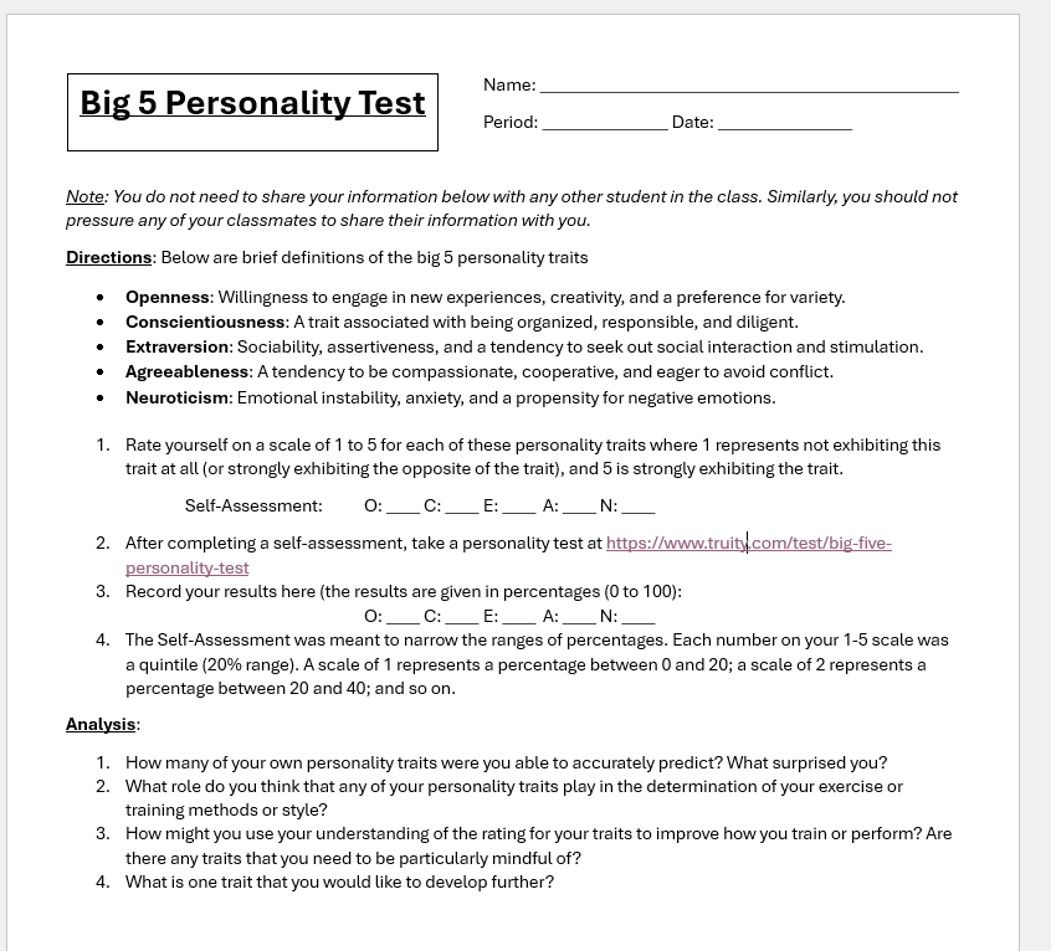C.1.1.1 Personality
What is personality?
Personality is the relatively stable and enduring aspects of individuals that distinguish them from other people, or the parts about us that remain the same over time, making us different from other people.
A lack of stability would mean an inability to study and an inability to predict
Social skills are an important ability to interact with other people’s personalities, about which we make predictions from prior experiences.
Trait-based approaches
Assumes that personality components are stable
Psychometric tools to measure personality:
State - how a person might respond at any one point in time. A feeling or behaviour. Eg. At this moment, I am careful
Trait personality factors - the prevailing factors contributing to a personality that are stable over a long time
Traits make you more likely to act a certain way, while state is how you are acting
The big five personality traits
In this model, there are five major dimensions of personality (O.C.E.A.N):
Openness to experience - likelihood to try new things
Someone with a high level of openness to experience likes trying new things.
Someone with a low level of openness to experience prefers doing the same things over and over again
Conscientiousness - responsibility and organisation
Someone with high levels is responsible, organised, and hard-working, whereas someone with low levels is the opposite
Extraversion - likelihood to be social and be around other people
Describes how outgoing and social a person is
Someone with high levels of extraversion loves being around other people
The opposite would be introversion - spending time alone and doing activities on their own
Agreeableness - cooperativeness, friendliness
Describes how friendly and cooperative a person is. Someone with a high level will be kind, considerate and likes to help others.
Neuroticism - emotional instability and anxiety
Describes how someone experiences and handles their emotions
Someone with a high level of neuroticism tends to worry a lot, gets easily upset or anxious, and feels stressed in different situations
The opposite would be emotional stability

Step 1: Self-Assessment: O: 4 C: 4 E: 2 A: 3 N: 1
Step 2/3: Personality Test Scores: O: 3 C: 4 E: 3 A:4 N: (low) 2
Analysis
I was only able to predict my conscientiousness, which in itself is already surprising, as I thought my predictions would align more with openness and extraversion.
Well, I tend to prefer a more structured training, so I don’t want my schedule to change much. That’s why my openness might be low, but when I am training, I tend to be more extroverted with my teammates cause I find we all have something in common, which I enjoy. I will end up agreeing with whatever I am told to as long as I get to train. Moreover, I remain the same with my emotions throughout the entire training and during games.
I think I should be more open during my training.
I would like to develop my openness and extraversion, maybe.
Measuring personality
LOTS
L- data: Lifetime history
O-data: Observations from friends and family
T-data: Tests (standardised/experimental)
S-data: Self-reported information
Data is used to examine how the environment affects these traits, how they might change over time, and how they affect an individual’s decision-making process.
Sports performance
No known connection between the Big 5 personality traits and elite athletes, but some have associations
Extraversion and conscientiousness link to sticking to programs
Neuroticism negatively correlated to activity
Low openness likely won’t try new activities, workout programs, or sports
Each end of the spectrum has its benefits in various situations, and will benefit various areas of sport differently
Perfectionism - can paradoxically lead to lower self-esteem and lower commitment
Adaptive perfectionsism: high standards, not concerned about what others think or mistakes
Maladaptive perfectionism: also high standards, but is concerned about what others think and mistakes
Shifting from both types of perfectionism is beneficial
Interactions View of Personality
Interactionism - personalities are developed constantly through interactions of the person and the environment
B=f(P, E) (Behaviour is a function of the Person and their Environment
Social-cognitive View of Personality
Suggests that personality isn’t fixed but shaped by how people think, learn from others, and interact with their environment.
It focuses on four key personality variables:
Competencies – the skills and abilities a person has (e.g., decision-making, problem-solving, sporting skills).
Encoding strategies – how people perceive and process information (e.g., an athlete may see a challenge as exciting, while another sees it as stressful).
Expectancies – what people believe will happen in a situation (e.g., “If I train hard, I’ll improve my performance”).
Plans – the goals, strategies, and self-regulation people use to guide their behaviour (e.g., setting a training plan to reach a performance target)